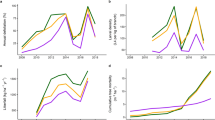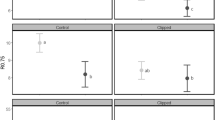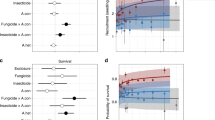Abstract
Explanations for the low levels of defoliation in natural woodlands1–6 have assumed that Insect herbivores have a negligible effect on plant fitness and demography7,8, perhaps because of plant compensation9–11. Levels of defoliation between 5 and 15% are typical, and are attributed variously to the impact of natural enemies, inclement weather and low food quality in keeping herbivore populations at low densities12,13 (but see refs 14, 15). Here I report the results of a 4-yr study in which matched pairs of oak trees, Quercus robur, were sprayed regularly to exclude all herbivorous insects; despite the fact that the unsprayed trees lost only 8–12% of their leaf area, the sprayed trees consistently produced more seeds (from 4.5 to 2.5 times the numbers on unsprayed plants). It is not known whether this substantial reduction in seed production actually leads to a reduction in plant recruitment. It does seem, however, that plant compensation is not fully effective against low-density herbivore populations and, therefore, that slight differences in the level of defoliation between plants may cause important differences in plant fitness.
This is a preview of subscription content, access via your institution
Access options
Subscribe to this journal
Receive 51 print issues and online access
$199.00 per year
only $3.90 per issue
Buy this article
- Purchase on Springer Link
- Instant access to full article PDF
Prices may be subject to local taxes which are calculated during checkout
Similar content being viewed by others
References
Bray, J. R. Ecology 45, 165–167 (1964).
Golley, F., Odum, H. T. & Wilson, R. F. Ecology 43, 9–19 (1962).
Haukioja, E. Tundra Ecosystems: A Comparative Analysis (eds Bliss, L. C., Heal, O. W. & Moore, J. J.) 547–555 (Cambridge University Press, 1981).
Kaczmarek, W. Secondary Productivity of Terrestrial Ecosystems (ed. Petrusewicz, K.) 663–678 (IBP, Warsaw, 1967).
Reichle, D. E., Goldstein, R. A., Van Hook, R. I. & Dodson, G. J. Ecology 54, 1076–1084 (1973).
Rothacher, J. S., Blow, F. E. & Potts, S. M. J. For. 52, 169–173 (1954).
Gradwell, G. The British Oak (eds Morris, M. G. & Perring, F. H.) 182–193 (Classey, Farringdon, 1974).
Jameson, D. A. Bot. Rev. 29, 532–594 (1963).
Crawley, M. J. Herbivory (Blackwell Scientific, Oxford, 1983).
Heichel, G. H. & Turner, N. C. Oecologia (Berlin) 57, 14–19 (1983).
Varley, G. C. & Gradwell, G. R. Proc. 11th int. Congr. Ent. 2, 211–214 (1962).
May, R. M. Theoretical Ecology 2nd edn (Blackwell Scientific, Oxford, 1981).
Price, P. W. et al. A. Rev. ecol. Syst. 11, 41–65 (1980).
Morrow, P. A. & LaMarche, V. C. Science 210, 1224–1226 (1978).
Stevens, G. R. Conn. agric. exp. Stn Bull. 796, 1–13 (1981).
Worthing, C. R. The Pesticide Manual 7th edn (British Crop Protection Council, London, 1983).
Southwood, T. R. E. Ecological Methods 2nd edn (Chapman & Hall, London, 1976).
Collins, M., Crawley, M. J. & McGavin, G. C. Ecol. Ent. 8, 133–138 (1983).
Caswell, H. Ecology 63, 1218–1222 (1982).
Stearns, S. C. Oikos 35, 266–281 (1980).
Torrent, J. A. FAO Pl. Prot. Bull. 3, 117–121 (1955).
Kulman, H. M. A. Rev. Ent. 16, 289–324 (1971).
Rockwood, L. L. Ecology 54, 1363–1369 (1973).
Heichel, G. H. & Turner, N. C. Oecologia (Berlin) 62, 1–6 (1984).
Author information
Authors and Affiliations
Rights and permissions
About this article
Cite this article
Crawley, M. Reduction of oak fecundity by low-density herbivore populations. Nature 314, 163–164 (1985). https://doi.org/10.1038/314163a0
Received:
Accepted:
Issue Date:
DOI: https://doi.org/10.1038/314163a0
This article is cited by
-
Retention of green leaves not brown leaves increases spring cynipid diversity on large valley oaks
Arthropod-Plant Interactions (2021)
-
Eucalyptus Edge Effect on Quercus-Herbivore Interactions in a Neotropical Temperate Forest
Neotropical Entomology (2019)
-
The Carbon Cycle of a Maritime Ancient Temperate Broadleaved Woodland at Seasonal and Annual Scales
Ecosystems (2015)
-
Lagged effects of early-season herbivores on valley oak fecundity
Oecologia (2015)
-
Defoliation by gypsy moths negatively affects the production of acorns by two Japanese oak species
Trees (2015)
Comments
By submitting a comment you agree to abide by our Terms and Community Guidelines. If you find something abusive or that does not comply with our terms or guidelines please flag it as inappropriate.



